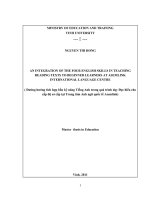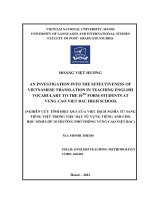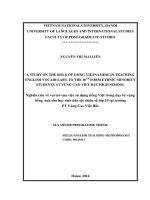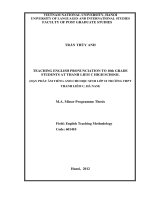Dificulties in teaching English pronunciation to 11-form student at Yen Vien High school and possible solutions
Bạn đang xem bản rút gọn của tài liệu. Xem và tải ngay bản đầy đủ của tài liệu tại đây (178.03 KB, 6 trang )
Dificulties in teaching English pronunciation to
11-form student at Yen Vien High school and
possible solutions
Trần Thị Thu Giang
Trường Đại học Ngoại Ngữ
Luận văn ThS. Chuyên ngành: English Linguistics; Mã số: 60 22 15
Người hướng dẫn: Assoc. Prof. Dr. Võ Đại Quang
Năm bảo vệ: 2010
Keywords: Tiếng Anh; Phát âm; Học sinh; Lớp 11
Content:
Part 1: Introduction
1. Rationale
Pronunciation teaching is a prominent factor in foreign language teaching. Since sounds
play an important role in communication, foreign language teachers must be aware of the
importance to teaching pronunciation in their classes. However, this fact is very much neglected
by many foreign teachers.
At my upper secondary school, teaching and learning pronunciation is a really new
challenging job. In addition to the lack of well-equipped facilities, teaching pronunciation
methods are quite new and unfamiliar to teachers. Since the new English textbook was in use,
they have been inexperienced in teaching pronunciation methodology and approaches. Another
problem is students’ low levels of proficiency in term of vocabulary, grammar, listening and so
on. And they are afraid of losing face. They are the reasons why students find it difficult to touch
to and they are not confident enough to communicate with others in English. Moreover, all
important English exams at school as well as the entrance exam to Universities are always
written form so most teachers as well as students have little motivation to teach and to learn
pronunciation. In my opinion, there is much to work out current and potential problems, and then
create better suitable teaching methods and strategies that can facilitate the effectiveness of
pronunciation lessons.
In the literature obtained so far, there have been so few studies on the difficulties in
English pronunciation teaching and learning. And up to now, there has not been any study on
difficulties in teaching English pronunciation at Yen Vien high school yet.
Thus, the case study of difficulties in teaching English pronunciation to 11-form students
at Yen Vien high school is of special importance. Once the difficulties are found out, solutions to
the problems can be worked out.
2. Aim of the study
The specific aims of the study are:
- To investigate and identify the types of difficulties encountered by teachers at Yen Vien
high school in their daily pronunciation teaching to 11-form students with the textbook
“English 11”.
- To suggest some solutions to the identified difficulties.
3. Research questions
The research is carried out with an attempt to find out answers to following research
questions:
- What kind of difficulties do high school teachers encounter when they use the textbook
“English 11” to teach English pronunciation to their students?
- What are the possible solutions to those difficulties?
4. Methods of the study
4.1. Subjects of the study
In order to achieve the aims of the thesis and answers to the above research questions, the
participants of the study include: a group of 9 teachers at Yen Vien high school. 8 of them a
female and one is male. All of them have taught the textbook “English 11” for 3 years.
Besides, in order to get more information for the answers to research questions, 100
students of the 11
th
form were surveyed, 70% of them are female. They were selected from
twelve classes of the 11
th
form at Yen Vien high school. They started learning English from
Lower- Secondary schools.
4.2. Data collection instruments
The research is done by both quantitative and qualitative methods; it is carried out on the
basis of situation analysis, material collection, survey questionnaires, and class observation and
recording. These instruments bring about the data for analysis, and evaluation.
4.3. Data collecting procedure
The data for such a research as this is collected through the procedure of analyzing and
synthesizing data and the procedure of discussing the results obtained from questionnaires and
observation, recording and interview. The concluding hypotheses are piloted to check their
validity.
4. 4. . Data analysis
- Qualitative analysis
Students’ responses to correction in class and their recordings are analyzed
- Quantitative analysis
Results of questionnaires and interview are analyzed
5. Scope of the study
The study is confined to the investigation of difficulties in teaching English pronunciation
in the Language focus part of English textbook “Tieng Anh 11” to 11- form students at Yen Vien
High school. The solutions are also provided to help improve the teaching and learning of
English pronunciation at Yen Vien High school.
6. Significance of the study
The study supplies English language teachers with an understanding of difficulties in
teaching and learning English pronunciation to 11
th
form students at Yen Vien High school.
The research provides the language teachers and learners with some solutions to the
identified difficulties in their teaching and learning English pronunciation.
7. Design of the study
The study is divided into three parts:
The first part is the Introduction, which presents the rationale for the study, the aims, and
methods, scope of the study as well as the designed of the thesis.
The second part is the Development of the study, divided into 3 chapters:
- Chapter 1: Literature review: This chapter provides the theoretical background and an
overview of the textbook “English 11” and current situation of teaching the textbook at
Yen Vien high school.
- Chapter 2: Findings and discussion
- Chapter 3: Proposed solutions
The last part is the Conclusion of the study, which summarizes the study, states the
limitations of the study and recommendation for further research.
References
Tiếng Anh
1. Avery, P., & Ehrlich, S (1992), Teaching American English pronunciation, New York:
Oxford University Press.
2. Carey, Michael. (2002), An L1-specific CALL pedagogy for the instruction of
pronunciation with Korean learners of English, Unpublished PhD Dissertation,
Macquarie: Macquarie University.
3. Celce-Murcia, M. and J.Goodwin (1991), Teaching pronunciation, in Celce-Murcia, M.
(ed) Teaching English as a Second or Foreign Language, Boston: Heinle & Heinle
Publishers, p.p: 136-153.
4. Celce-Murcia, N., Brinton, M. D., & Goodwin, J. M. (1996), Teaching Pronunciation. A
reference for teachers of English to speakers of other languages, New York: CUP.
5. Dalton, C., & Seidlhofer, S. (1994), Pronunciation, New York, NY: Oxford University
Press.
6. Davis, C. (1999), Will the use of videos designed for the purpose of teaching English
pronunciation improve the learners’ production of discrete sounds by at least 80% over a
12-week period? In Action Research Monographs, Pennsylvania Action Research
Network, 1988-99, A Section 353 Project of the Pennsylvania Department of Education,
Bureau of Adult Basic and Literacy Education. ERIC Document [ED440 219]
7. Fraser, H. (2000a), Coordinating improvements in pronunciation teaching for adult
learners of English as a second language, Canberra: DETYA (Australia National
Training Authority Adult Literacy Project) Retrieved October 31, 2004, from http://www
personal.une.edu.au/~hfraser/docs/HF_ANTA_REPORT.pdf
8. Ha Cam Tam (2005), Common pronunciation problems of Vietnamese learners of
English, Journal of Science, T. XXI, No1- VNU.
9. Mc Donough, J. and Mc Donough, S. (1997), Research Methods for ELT, London
Arnold.
10. Kenworthy, J. (1987), Teaching English pronunciation, New York: Longman.
11. Morley, J. (1991), The pronunciation Component in Teaching English to speakers of
Other Languages, TESOL Quarterly, 25, 3: 481- 520.
12. Nunan, D. (1992), Research Methods in Language Learning, Cambridge: Cambridge
University Press.
13. Richards, J.C. and T. Rodgers, (1986), Approaches and Methods in Language Teaching:
A description and analysis, Cambridge: CUP
14. Suter, R. (1976), Predictors of pronunciation accuracy in second language learning,
Language Learning, 26, 233-253.
15. Tim Bowen and Jonathan Marks. (1992), The Pronunciation book, Singapore: Longman
Tiếng Việt
1. Đoàn Thiện Thuật (1977), Ngữ âm Tiếng Việt, Hà nội, Nhà xuất bản Đại Học và Trung
học chuyên nghiệp.









